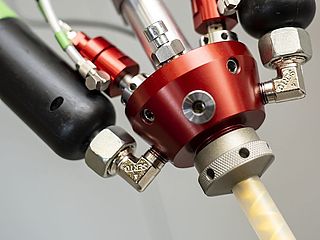On the podium with metrology

Since the 1960s, skis have been manufactured almost exclusively as foam or composite constructions that stand for better skiing characteristics. But what is it about skis that actually turn professional skiers into winners? "An important performance feature of alpine skis, especially in racing, is edge geometry and edge radius," explains Thomas Elsinger, Field Sales Engineer at Mahr Austria GmbH. "An edge angle above two degrees on the running surface provides almost no grip on the piste. In contrast, an edge between zero and 0.5 degrees that is too sharp is too aggressive and can lead to injuries." In mass sports, the edge almost always has an angle between one and 1.5 degrees. In racing, professional athletes mostly decide for themselves which edge angle and which base structure will put them ahead.
Meaningful measurement results
Edge and coating measurements can be taken at any number of points on the running surface, sides and bottom edge. "The standard is defined as five measurement points along the length of the measured object," explains his colleague Michael Parzer, also a field sales engineer at the Austrian Mahr subsidiary. "As a rule, a complete edge measurement is composed of three to five measurement fields per side and bottom edge, depending on the ski length, in order to achieve a meaningful overall result via the average value." When inspecting the base, however, it depends very much on the type of object how many measuring points have to be examined.

Metrology for more performance
To ensure micrometer-accurate surfaces, skis are randomly inspected during production. Most manufacturers fix the ski in a fixture for this purpose, which then positions it relative to the drive unit. The MarSurf XR 1, for example, is used here: the measuring system consists of a drive unit (SD 26 / GD 26), a BFW touch probe, and the proven MarWin Easy Roughness & Contour software. "The MarSurf XR 1 combines mobile surface metrology with the advantages of the MarWin evaluation software. This means that a simple all-in-one PC and the appropriate drive unit are all that is needed for a roughness, waviness and contour measurement," says Parzer. Depending on their measuring tasks, users can decide whether they want to configure the measuring station with skidded or skid-free systems. The PC-based device provides all common parameters and profiles of the international standards. The drive units can be connected via wireless or cable.
Interactive operating elements
The measuring and evaluation software makes it very easy to control and position the drive unit and measuring stand. The various interactive operating elements support the evaluations and automatic processes. Even different tolerances within a profile can be selected. Import and export of .dxf files is also supported. A target-actual comparison thus succeeds effortlessly.
However, roughness is only one of several indicators of a ski's performance; its surface structures also play a decisive role in determining its performance: Coarse surfaces are particularly suitable for wet snow, while a fine texture scores points in dry snow. In addition, the type of ski – cross-country or downhill, for example – also determines which surface structure is needed.
What to measure:
▶ Edge measurement involves measuring the hanging edge. Modern metrology can be used to analyze the topography, line and surface roughness values, and the edge radius from the bottom edge to the side edge. The side edge is then concerned with its angle to the coating, but also with its topography and surface roughness values.
▶ For the coating measurement, the topography and surface roughness values as well as the bearing surface are the focus of the evaluations.



















